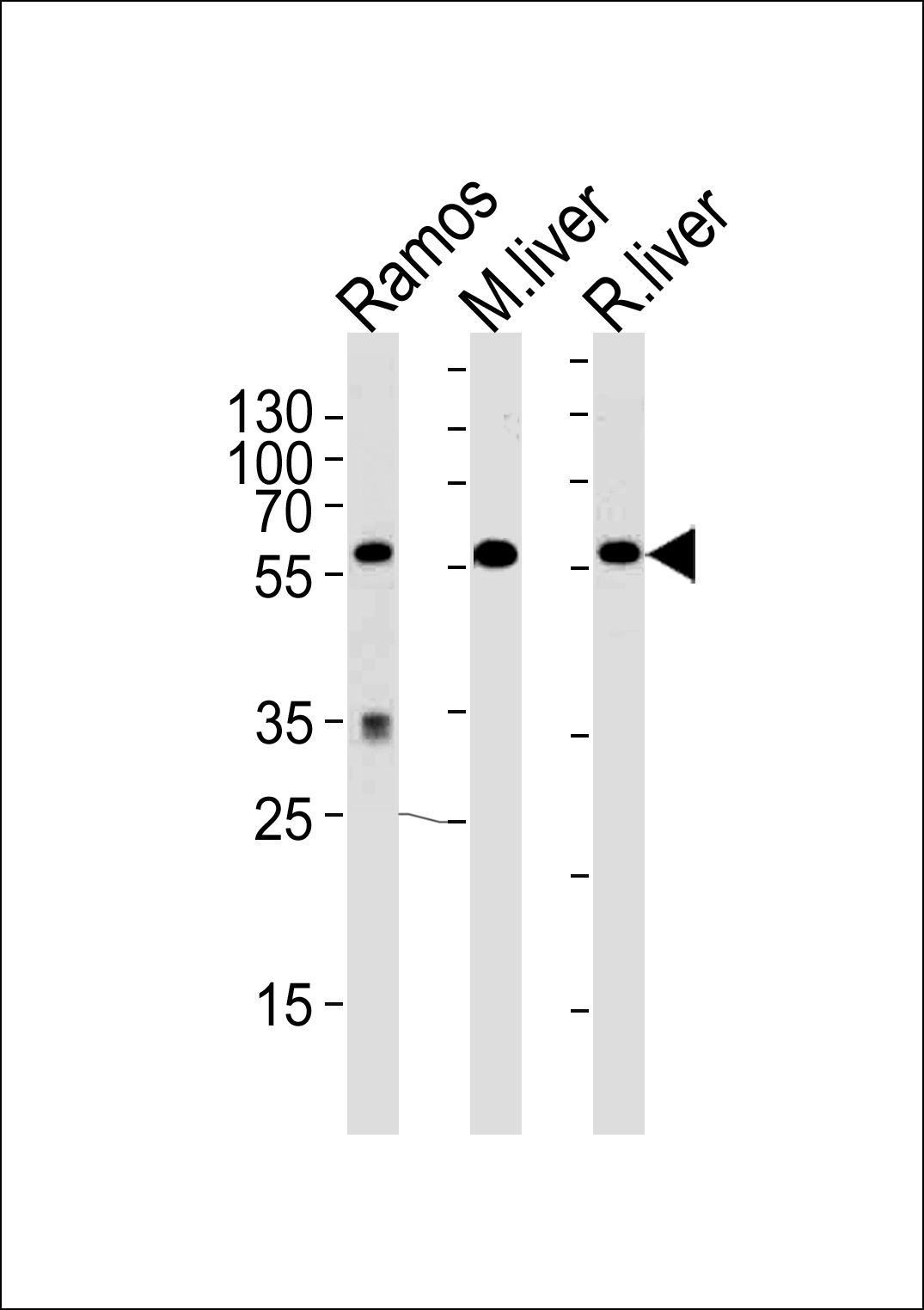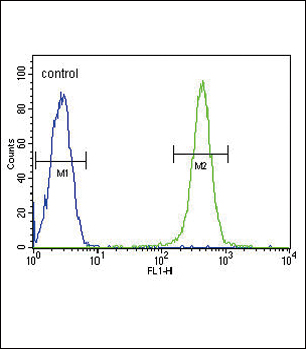GPI Antibody (C-term)
Affinity Purified Rabbit Polyclonal Antibody (Pab)
- 产品详情
- 文献引用 : 2
- 实验流程
- 背景知识
Application
| FC, WB, E |
|---|---|
| Primary Accession | P06744 |
| Other Accession | Q4R591 |
| Reactivity | Human, Rat, Mouse |
| Predicted | Monkey |
| Host | Rabbit |
| Clonality | Polyclonal |
| Isotype | Rabbit IgG |
| Calculated MW | 63147 Da |
| Antigen Region | 445-473 aa |
| Gene ID | 2821 |
|---|---|
| Other Names | Glucose-6-phosphate isomerase, GPI, Autocrine motility factor, AMF, Neuroleukin, NLK, Phosphoglucose isomerase, PGI, Phosphohexose isomerase, PHI, Sperm antigen 36, SA-36, GPI |
| Target/Specificity | This GPI antibody is generated from rabbits immunized with a KLH conjugated synthetic peptide between 445-473 amino acids from the C-terminal region of human GPI. |
| Dilution | FC~~1:10~50 WB~~1:1000 E~~Use at an assay dependent concentration. |
| Format | Purified polyclonal antibody supplied in PBS with 0.09% (W/V) sodium azide. This antibody is purified through a protein A column, followed by peptide affinity purification. |
| Storage | Maintain refrigerated at 2-8°C for up to 2 weeks. For long term storage store at -20°C in small aliquots to prevent freeze-thaw cycles. |
| Precautions | GPI Antibody (C-term) is for research use only and not for use in diagnostic or therapeutic procedures. |
| Name | GPI {ECO:0000303|PubMed:2387591, ECO:0000312|HGNC:HGNC:4458} |
|---|---|
| Function | In the cytoplasm, catalyzes the conversion of glucose-6- phosphate to fructose-6-phosphate, the second step in glycolysis, and the reverse reaction during gluconeogenesis (PubMed:28803808). Besides it's role as a glycolytic enzyme, also acts as a secreted cytokine: acts as an angiogenic factor (AMF) that stimulates endothelial cell motility (PubMed:11437381). Acts as a neurotrophic factor, neuroleukin, for spinal and sensory neurons (PubMed:11004567, PubMed:3352745). It is secreted by lectin-stimulated T-cells and induces immunoglobulin secretion (PubMed:11004567, PubMed:3352745). |
| Cellular Location | Cytoplasm. Secreted |
For Research Use Only. Not For Use In Diagnostic Procedures.

Provided below are standard protocols that you may find useful for product applications.
BACKGROUND
GPI belongs to the GPI family whose members encode multifunctional phosphoglucose isomerase proteins involved in energy pathways. The protein encoded by this gene is a dimeric enzyme that catalyzes the reversible isomerization of glucose-6-phosphate and fructose-6-phosphate. The protein functions in different capacities inside and outside the cell. In the cytoplasm, the gene product is involved in glycolysis and gluconeogenesis, while outside the cell it functions as a neurotrophic factor for spinal and sensory neurons. Defects in this gene are the cause of nonspherocytic hemolytic anemia and a severe enzyme deficiency can be associated with hydrops fetalis, immediate neonatal death and neurological impairment.
REFERENCES
Shih, W.L., et al. Cancer Lett. 290(2):223-237(2010)
Davila, S., et al. Genes Immun. 11(3):232-238(2010)
Araki, K., et al. J. Biol. Chem. 284(47):32305-32311(2009)
Tsutsumi, S., et al. Int. J. Oncol. 35(5):1117-1121(2009)
Funasaka, T., et al. Cancer Res. 69(13):5349-5356(2009)
Yanagawa, T., et al. J. Biol. Chem. 280(11):10419-10426(2005)
Haga, A., et al. Biochim. Biophys. Acta 1480 (1-2), 235-244 (2000)
终于等到您。ABCEPTA(百远生物)抗体产品。
点击下方“我要评价 ”按钮提交您的反馈信息,您的反馈和评价是我们最宝贵的财富之一,
我们将在1-3个工作日内处理您的反馈信息。
如有疑问,联系:0512-88856768 tech-china@abcepta.com.






















 癌症的基本特征包括细胞增殖、血管生成、迁移、凋亡逃避机制和细胞永生等。找到癌症发生过程中这些通路的关键标记物和对应的抗体用于检测至关重要。
癌症的基本特征包括细胞增殖、血管生成、迁移、凋亡逃避机制和细胞永生等。找到癌症发生过程中这些通路的关键标记物和对应的抗体用于检测至关重要。 为您推荐一个泛素化位点预测神器——泛素化分析工具,可以为您的蛋白的泛素化位点作出预测和评分。
为您推荐一个泛素化位点预测神器——泛素化分析工具,可以为您的蛋白的泛素化位点作出预测和评分。 细胞自噬受体图形绘图工具为你的蛋白的细胞受体结合位点作出预测和评分,识别结合到自噬通路中的蛋白是非常重要的,便于让我们理解自噬在正常生理、病理过程中的作用,如发育、细胞分化、神经退化性疾病、压力条件下、感染和癌症。
细胞自噬受体图形绘图工具为你的蛋白的细胞受体结合位点作出预测和评分,识别结合到自噬通路中的蛋白是非常重要的,便于让我们理解自噬在正常生理、病理过程中的作用,如发育、细胞分化、神经退化性疾病、压力条件下、感染和癌症。







